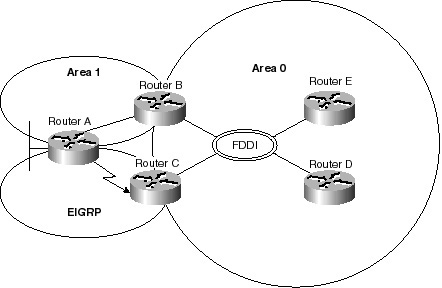Advanced OSPF Design Concepts
Design Scenario #4: Site Router Is in Two Routing Domains This approach relies on one-way redistribution of multiple instances of a separate routing protocol into OSPF as shown in Figure 6-13. Auto-summarization must also be disabled in this scenario. Administrative distances should be tweaked to ensure that OSPF is the favored routing protocol. This approach has the advantage that interfaces may be shared among areas; that is, a dedicated set of interfaces for each area is not required.
Included are some sample configurations for this design scenario. Router A Configuration interface ethernet 0 ip address 132.132.132.193 255.255.255.224 interface serial 0 ip address 132.132.132.254 255.255.255.252 backup interface serial 1 backup delay 0 5 interface serial 1 ip address 132.132.132.250 255.255.255.252 router ospf 1 network 132.132.132.192 0.0.0.31 area 1 network 132.132.132.252 0.0.0.3 area 1 router eigrp 1 network 132.132.0.0 distance 200 0.0.0.0 255.255.255.255 Router B Configuration interface fddi 0 ip address 132.132.1.1 255.255.255.248 interface serial 0 ip address 132.132.132.253 255.255.255.252 router ospf 1 network 132.132.132.0 0.0.3.255 area 1 area 1 range 132.132.132.0 255.255.252.0 network 132.132.0.0 0.0.255.255 area 0 Router C Configuration interface fddi 0 ip address 132.132.1.2 255.255.255.248 interface serial 0 ip address 132.132.132.249 255.255.255.252 router ospf 1 network 132.132.1.0 0.0.0.7 area 0 redistribute eigrp 1 subnets metric 32000 router eigrp 1 network 132.132.0.0 passive-interface fddi 0 distance 200 0.0.0.0 255.255.255.255 The preceding examples work with dial-on-demand routing as well as dial-backup. One should set the metric on the backup interface to be less favorable than that on the primary. Also, be certain to set the administrative distance on the backup routing protocol to be greater than that of the primary (both of these so as to allow the idle timer to work). The redistribution of a static route for the backed-up site is absolutely necessary. Not only does it speed convergence somewhat, it is the controlling factor in directing traffic at the upstream dial-on-demand interface to trigger dialing. After the primary interface goes down, all knowledge of the site LAN is lost. If the backup server is originating routes for the site LANs at a much higher cost, these will now come into effect. OSPF Configuration CommandsThere are literally thousands of documented and undocumented commands that can be used on Cisco equipment. These commands are found in several different areas and, of course, differ by IOS. These differences might not be major in the case of OSPF, but I recommend you have a set for each version of IOS in your network.
At first glance, it might seem that the variety of information sources available is wonderful. But what the uninitiated does not realize is that the various commands are spread out within each source. There is no one link that takes you to all the OSPF commands that Cisco routers have available. This chapter is concerned about OSPF and only the commands associated with its configuration, design, and operation. Specifically, this chapter deals with the various commands that can set up or alter the performance of OSPF within a network. This section will provide you with an exhaustive list of Cisco router configuration commands dealing specifically with the OSPF protocol. Hopefully, you will find this section to be a valuable resource. Of course, all of this information can be found with various Cisco sources as detailed above, but not all in one place! The following section covers the various commands used within a Cisco router to configure OSPF authentication. These entries follow a specific format (where applicable):
area authenticationTo enable authentication for an OSPF area, use the area authentication router configuration command. To remove an area’s authentication specification or a specified area from the configuration, use the no form of this command. area area-id authentication [message-digest] no area area-id authentication no area area-id Syntax Description:
area default-costTo specify a cost for the default summary route sent into a stub area, use the area default-cost router configuration command. To remove the assigned default route cost, use the no form of this command. The syntax for this command (and the no form) is as follows: area area-id default-cost cost no area area-id default-cost cost Syntax Description:
Default: Cost of 1. Command Mode: Router configuration.
|
EAN: 2147483647
Pages: 200
